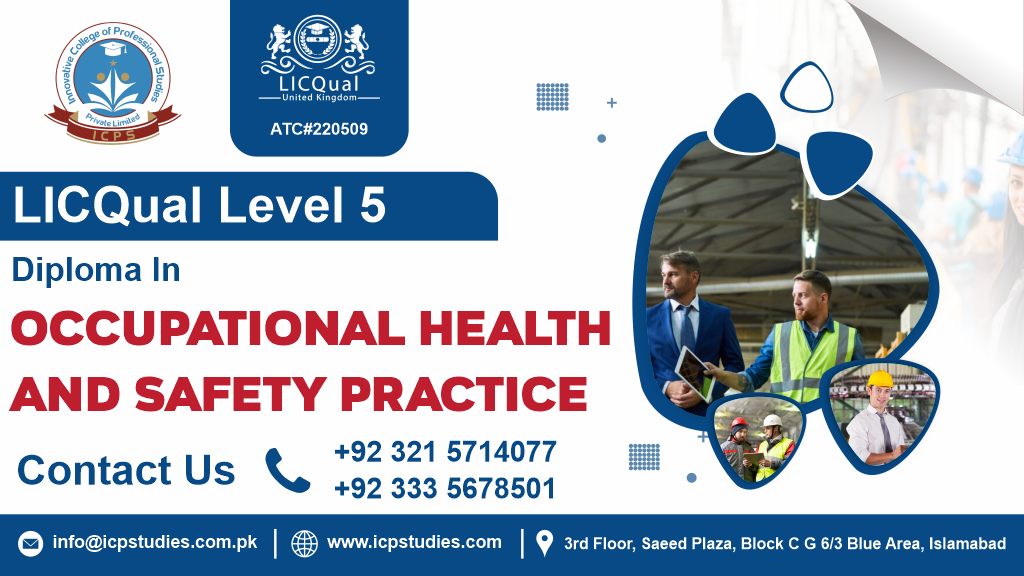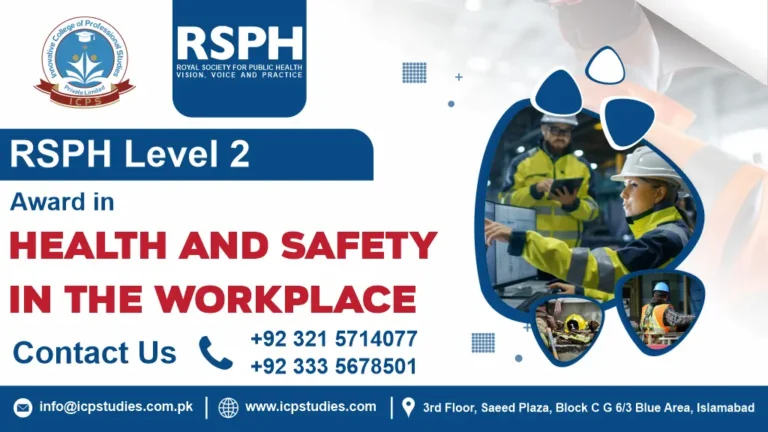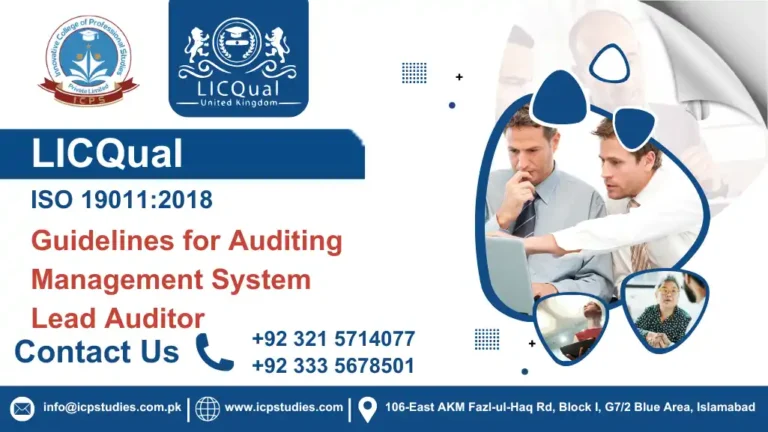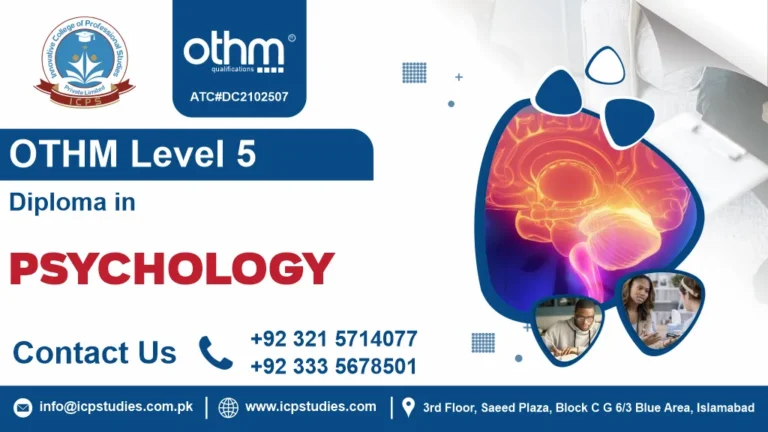Developed by industry experts, our comprehensive curriculum covers all aspects of occupational health and safety management, from risk assessment to compliance strategies. You’ll gain practical skills and theoretical knowledge that are directly applicable to your role.
LICQual is globally recognized for its commitment to excellence in education and training. By earning your Level 5 Diploma, you’ll enhance your credibility and stand out in a competitive job market.
Whether you’re looking to progress in your current role or pursue new opportunities, this diploma equips you with the expertise to take on leadership positions in health and safety management. Employers value professionals who prioritize safety in the workplace, and this qualification demonstrates your dedication to creating a secure and healthy environment for all.
We understand that balancing work and study can be challenging. That’s why we offer flexible learning options, including online courses and part-time study, allowing you to tailor your learning experience to fit your schedule.
Invest in your future and elevate your career with the LICQual Level 5 Diploma in Occupational Health and Safety Practice. Join the ranks of industry leaders who are making a difference in workplace safety and health worldwide. Don’t wait any longer Enroll now and embark on a rewarding journey towards professional excellence and personal growth.
All About Level 5 Diploma in Occupational Health and Safety Practice
Course Overview
The LICQual Level 5 Diploma in Occupational Health and Safety Practice is a comprehensive program designed to equip professionals with the knowledge, skills, and competencies needed to effectively manage health and safety in the workplace. This diploma course covers a wide range of topics essential for ensuring the well-being of employees and compliance with relevant regulations and standards.
Participants learn how to identify workplace hazards, assess risks, and implement appropriate control measures to minimize or eliminate risks. This includes understanding the principles of risk management and applying them in various occupational settings.
The course covers relevant health and safety legislation, regulations, and standards at both national and international levels. Participants gain an understanding of their legal responsibilities as employers or health and safety practitioners and learn how to ensure compliance within their organizations.
Participants learn how to develop and implement emergency response plans, including procedures for handling accidents, incidents, and emergencies such as fires, chemical spills, or medical emergencies. This includes training in first aid, evacuation procedures, and crisis communication.
The course explores strategies for promoting employee health and well-being in the workplace. This may include topics such as ergonomic assessments, mental health awareness, promoting physical activity, and managing stress in the workplace.
The LICQual Level 5 Diploma in Occupational Health and Safety Practice typically combines theoretical knowledge with practical application through case studies, simulations, and real-world scenarios. Participants may also have opportunities for hands-on experience through site visits, internships, or practical assignments.
Upon successful completion of the course, participants receive a recognized diploma that demonstrates their expertise and competence in occupational health and safety management. This qualification can enhance career prospects, open up new job opportunities, and contribute to creating safer and healthier workplaces.
Study Units
Learning Outcomes
Here are the outcomes corresponding to each of the study units:
- Develop and implement effective communication systems for health and safety information:
- Outcome: Participants will be able to design and establish communication channels and protocols to ensure timely and accurate dissemination of health and safety information throughout the organization.
- Promote a positive health and safety culture:
- Outcome: Participants will gain the skills to foster a culture of safety within the organization by promoting awareness, accountability, and participation among employees at all levels.
- Develop and maintain individual and organizational competence in health and safety matters:
- Outcome: Participants will learn strategies for assessing and enhancing the competence of individuals and the organization as a whole in health and safety practices through training, education, and professional development initiatives.
- Control health and safety risks:
- Outcome: Participants will develop the ability to identify, assess, and prioritize health and safety risks within the organization and implement control measures to mitigate or eliminate these risks effectively.
- Develop and implement proactive monitoring systems for health and safety:
- Outcome: Participants will be equipped to design and implement systems for ongoing monitoring and surveillance of workplace conditions, behaviors, and practices to identify potential hazards and risks before they result in incidents or accidents.
- Develop and implement reactive monitoring systems for health and safety:
- Outcome: Participants will learn how to establish procedures and protocols for responding to incidents, accidents, and near misses in a timely and effective manner, including reporting, investigation, and corrective action.
- Develop and implement health and safety emergency response systems and procedures:
- Outcome: Participants will gain the skills to develop comprehensive emergency response plans and procedures tailored to the specific needs and risks of the organization, ensuring a prompt and coordinated response to emergencies.
- Develop and implement health and safety review systems:
- Outcome: Participants will be able to establish systems for conducting regular reviews and evaluations of health and safety performance, practices, and policies to identify areas for improvement and ensure ongoing compliance with regulations and standards.
- Develop and implement a health and safety audit:
- Outcome: Participants will learn how to plan, conduct, and report on health and safety audits to assess the effectiveness of health and safety management systems, identify non-conformities, and recommend corrective actions to drive continuous improvement.
These outcomes collectively equip participants with the knowledge, skills, and tools needed to effectively manage health and safety in the workplace and contribute to creating a safer and healthier work environment.
Admission Criteria
Here are the typical entry requirements for the LICQual Level 5 Diploma in Occupational Health and Safety Practice:
- Educational Background:
- A minimum of a high school diploma or equivalent qualification is usually required.
- Some institutions may require applicants to have completed certain prerequisite courses in health and safety, environmental science, or related fields.
- Work Experience:
- While not always mandatory, many programs prefer candidates with relevant work experience in health and safety, occupational hygiene, risk management, or a related field.
- Typically, candidates are expected to have a minimum of one to three years of work experience in a relevant industry or occupational setting.
- English Language Proficiency:
- Since the course materials and assessments are often conducted in English, applicants may be required to demonstrate proficiency in the English language.
- This can be proven through standardized tests such as the TOEFL (Test of English as a Foreign Language) or IELTS (International English Language Testing System), or through other recognized language proficiency assessments.
- Additional Requirements:
- Some institutions may require applicants to submit a resume or curriculum vitae (CV) detailing their educational background, work experience, and any relevant certifications or qualifications.
- Applicants may also be asked to provide letters of recommendation or references from employers, supervisors, or academic instructors who can attest to their suitability for the program.
- Interview or Statement of Purpose:
- Depending on the institution, applicants may be required to participate in an interview or submit a statement of purpose outlining their interest in the course, career goals, and reasons for pursuing further education in occupational health and safety.
- Health and Safety Clearance:
- Given the nature of the course, applicants may need to demonstrate compliance with health and safety requirements, such as vaccinations or medical screenings, particularly if the program involves practical or on-site components.
It’s important to note that specific entry requirements may vary depending on the institution offering the course and the country in which it is being pursued. Prospective students are encouraged to carefully review the entry requirements outlined by the institution of their choice and ensure that they meet all criteria before applying.
Ideal Candidate
This course is suitable for a diverse range of professionals, including:
- Health and Safety Practitioners: Individuals already working in the field of occupational health and safety who are looking to deepen their knowledge, enhance their skills, and obtain a recognized qualification to advance their careers.
- Safety Officers and Managers: Professionals responsible for overseeing health and safety practices within organizations, including safety officers, safety managers, and safety coordinators, who seek to broaden their understanding and effectiveness in managing workplace safety.
- Human Resources (HR) Professionals: HR professionals who play a role in developing and implementing health and safety policies, procedures, and programs within their organizations and wish to strengthen their expertise in this area.
- Environmental Health Officers: Individuals involved in environmental health, public health, or regulatory enforcement roles who want to expand their knowledge and skills in occupational health and safety management.
- Facility Managers and Supervisors: Facility managers, operations managers, and supervisors responsible for overseeing workplace environments and ensuring compliance with health and safety regulations who aim to enhance their ability to create safer working environments.
- Industry Specialists: Professionals working in specific industries or sectors, such as construction, manufacturing, healthcare, oil and gas, transportation, or mining, where occupational health and safety risks are prevalent and require specialized knowledge and expertise.
- Recent Graduates: Graduates with a background in health sciences, environmental sciences, engineering, or related fields who are seeking to enter the occupational health and safety profession and want to acquire the necessary qualifications and skills to succeed in the field.
- Career Changers: Individuals looking to transition into a career in occupational health and safety from other fields such as engineering, project management, or quality assurance, who recognize the importance of health and safety in the workplace and wish to make a meaningful impact in this area.
Regardless of their background or current role, participants in this course share a common goal of improving workplace safety, protecting the health and well-being of employees, and contributing to the overall success and sustainability of their organizations. This course provides them with the knowledge, skills, and confidence to effectively manage health and safety challenges and drive positive change in their workplaces.
FAQs about Level 5 Diploma in Occupational Health and Safety Practice







